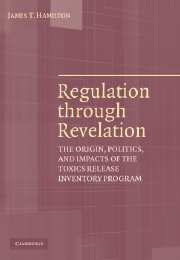 Regulation through Revelation
Regulation through Revelation Book contents
- Frontmatter
- Contents
- Acknowledgments
- Introduction
- 1 Legislating an Incomplete Contract
- 2 Defining Terms: Rulemaking and the Initial TRI Data Release
- 3 Spreading the Word in the Public and Private Sectors
- 4 Politics of Expansion and Contraction
- 5 Life Cycles in the Regulatory Environment
- 6 The Impact(s) of the TRI
- 7 Lessons from and for Regulatory Implementation
- Notes
- Bibliography
- Index
5 - Life Cycles in the Regulatory Environment
Published online by Cambridge University Press: 24 November 2009
- Frontmatter
- Contents
- Acknowledgments
- Introduction
- 1 Legislating an Incomplete Contract
- 2 Defining Terms: Rulemaking and the Initial TRI Data Release
- 3 Spreading the Word in the Public and Private Sectors
- 4 Politics of Expansion and Contraction
- 5 Life Cycles in the Regulatory Environment
- 6 The Impact(s) of the TRI
- 7 Lessons from and for Regulatory Implementation
- Notes
- Bibliography
- Index
Summary
The evolution of the Toxics Release Inventory program reflects the life cycles inherent in many elements of the regulatory environment. A common set of factors influences the course of an environmental regulation: public opinion; media coverage; inspection and enforcement decisions in the field and interpretations rendered by administrative law, state, and federal judges; and office politics (both within the EPA and across other federal agencies). These factors vary predictably across the life of a regulation, as evidenced by the history of the TRI program.
High levels of public concern with toxics fueled the passage of EPCRA. The toxic reporting program set in place by legislation continued even as public attention waned. Media coverage of the TRI program spiked in the popular press in 1995 and 1996, during the legislative battles over the TRI and the presidential election. Releases and TRI policy in subsequent years garnered less media coverage, in part because the novelty of the information provision program had declined and because the Bush II administration did not make TRI a high-profile policy. In the trade press aimed at industry readers and environmentalists, the TRI continually generated coverage because policy continued to change over time. Inspection and enforcement actions in the early years of the program were trumpeted by the EPA, in part as a way to convey reporting requirements to industry. In later years, agency officials focused limited enforcement resources on particular chemicals or industries as a way to improve compliance.
- Type
- Chapter
- Information
- Regulation through RevelationThe Origin, Politics, and Impacts of the Toxics Release Inventory Program, pp. 177 - 207Publisher: Cambridge University PressPrint publication year: 2005


